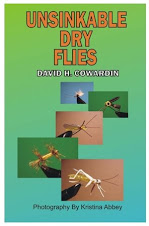
When working with a soldering iron even some 15 watt units may be to hot to allow effective shrinking of the heat shrink as I recently discovered. To solve this problem use an electronic soldering station that allows for variable heat. The Elenco Electronic Soldering Station Model SL-5 is available on the web for under $35.00 with shipping. They recommend a 40 watt iron but I still use a 15 watt and it works just fine.










 This final picture is of a finished fly using the wing and also a "Bubble" body (see book page 12) making this one
This final picture is of a finished fly using the wing and also a "Bubble" body (see book page 12) making this one 
